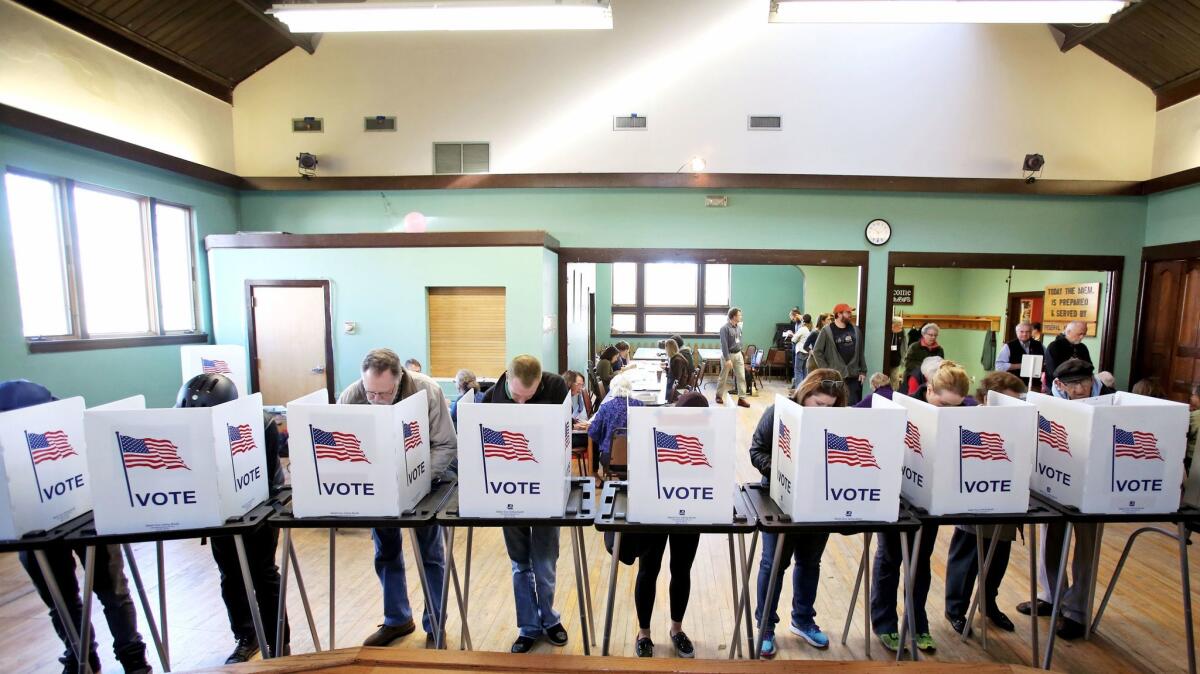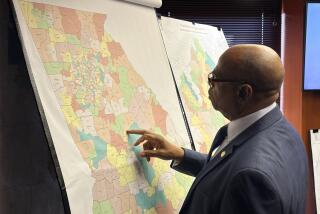For the first time, the Supreme Court seems receptive to putting limits on partisan gerrymanders

The Supreme Court heard a powerful plea for reining in partisan gerrymandering, and a majority on Tuesday seemed to lean in favor of a potential landmark ruling that for the first time would limit politicians from entrenching their party in power by clever drawing of legislative or congressional district lines.
The court has never before struck down election maps simply because they lock in an advantage for one party. But now is the time, the justices were told.
“Politicians are never going to fix gerrymandering. You are the only institution in the United States that can solve this problem,” Paul M. Smith, an attorney for the Wisconsin Democrats who brought the current case, told the justices. “And this is really the last opportunity” to act before the next round of redistricting following the census of 2020.
Justice Anthony M. Kennedy, who likely holds the deciding vote on the issue, appeared to agree. He told a Wisconsin state lawyer that he thought extreme partisan gerrymanders could be challenged on 1st Amendment grounds because they deny voters in the disfavored party a right to have their views represented.
That won’t work, the state attorney replied. “Let’s assume that it does,” Kennedy said.
If Kennedy holds to the position that he appeared to favor, the court will have five votes for a ruling later this term that would limit gerrymanders. That would have the potential to undermine Republican control of the House of Representatives as well as several state legislatures. Although Democrats also have practiced gerrymanders, they’ve had fewer opportunities in the current decade because they control fewer state legislatures.
Kennedy asked questions only of the lawyers defending the map drawn by Wisconsin’s Republicans. At one point, he asked one of them to imagine that a state passed a law saying its election maps would always “favor party X or party Y.”
“Is that constitutional?” he asked.
The lawyer ducked an answer. Kennedy tried again and still got no answer. “Well, it’s a little hard to say at this point,” said the lawyer, Erin Murphy. Certainly, the Republicans had not proclaimed they were drawing maps to favor their party, she added.
Kennedy was undeterred: “I’d like an answer to the question.”
“Yes, it would be unconstitutional,” she relented.
Kennedy said nothing further in the hourlong argument, but it was clear that he believed the Constitution would prevent one party from writing a law that kept it in power for a decade. The only remaining question was whether he believed Wisconsin’s Republicans had done essentially that when they went behind closed doors in 2011 and used computerized maps to ensure their hold on the state Legislature.
In 2010, Republicans nationwide scored big wins at the polls and took full control in at least half a dozen closely divided states. They used that power to draw election maps that strongly favored their party’s candidates.
Pennsylvania, Michigan, Ohio and North Carolina, for example, have 61 representatives among them in the U.S. House, of which 44 are Republicans and only 17 Democrats even though voters in those states are closely divided between the two parties.
In Wisconsin, the election map ensured the GOP would have a supermajority of at least 60 seats in the 99-member state Assembly, even in cases like the 2012 election, when Republican candidates won just 48% of the vote. Last year a three-judge court struck down the map, leading to the current case, Gill vs. Whitford.
Gerrymandering has been part of American politics for over 200 years. The word comes from the name of an early 19th century governor of Massachusetts, Elbridge Gerry, whose party drew a legislative map with a district that resembled a salamander.
In recent years, as computer technology has enabled parties to draw lines more precisely to maximize their advantage, discontent with the practice has increased. Several states, including California, have taken the power to draw legislative boundaries away from lawmakers and handed it to independent commissions. And legal advocates have repeatedly challenged the practice of partisan gerrymandering in court.
Democrats have taken the lead in opposing the practice because Republicans used gerrymanders so effectively after the 2010 election. Ironically, however, a ruling in Democrats’ favor could help the GOP in the next round of redistricting. Democrats tend to do better in presidential election years, and stand to score big wins in the closely divided states. If so, gerrymandering would give them a chance to redraw election maps in their favor after the 2020 census.
The last time the issue was before the court, in 2004, the justices declined to plunge into it. But Kennedy suggested at the time that he might be willing to consider the issue in a different case.
In Tuesday’s argument, the other eight justices sounded split along the usual ideological lines. The conservatives, led by Chief Justice John G. Roberts Jr., said the court should not get in the business of deciding partisan battles.
“We will have to decide in every case whether the Democrats win or the Republicans win,” he said. “That is going to cause very serious harm to the status and integrity of the decisions of this court in the eyes of this country.” Roberts dismissed the statistical measures of gerrymandering devised by lower-court judges as a “sociological gobbledygook.”
Justice Samuel A. Alito Jr. agreed. “Is this the time for us to jump into this?” he asked, suggesting the answer was no. Justice Neil M. Gorsuch said he did not see anything in the Constitution that authorized the court to intervene.
The four liberal justices were more certain that the court needed to act.
What about the “precious right to vote,” asked Justice Ruth Bader Ginsburg. “If they can stack the Legislature in this way, what incentive is there for a voter to exercise his vote?”
Justice Stephen G. Breyer said he did not need any “gobbledygook” to rule against the Wisconsin plan.
“If Party A wins a majority of votes, Party A controls the Legislature. That seems fair. And if Party A loses a majority of the votes, it still controls the legislature. That doesn’t seem fair,” he said.
Justice Elena Kagan noted that computers allow party officials to try out hundreds of maps to get the most advantage. It has “become extremely sophisticated” and can “entrench a party in power,” she said.
Smith used his closing argument to focus the justices on 2020 and beyond. If partisan gerrymandering is upheld, “you’re are going see people slicing and dicing a very polarized electorate to the point where one-party control will be guaranteed,” he said. “That’s going to become the norm.”
Twitter: DavidGSavage
ALSO
Trump calls for unity in the face of ‘pure evil’ while resisting talk of gun control
Trump again undercuts his secretary of State, dashing potential progress on North Korea
More to Read
Get the L.A. Times Politics newsletter
Deeply reported insights into legislation, politics and policy from Sacramento, Washington and beyond. In your inbox three times per week.
You may occasionally receive promotional content from the Los Angeles Times.







